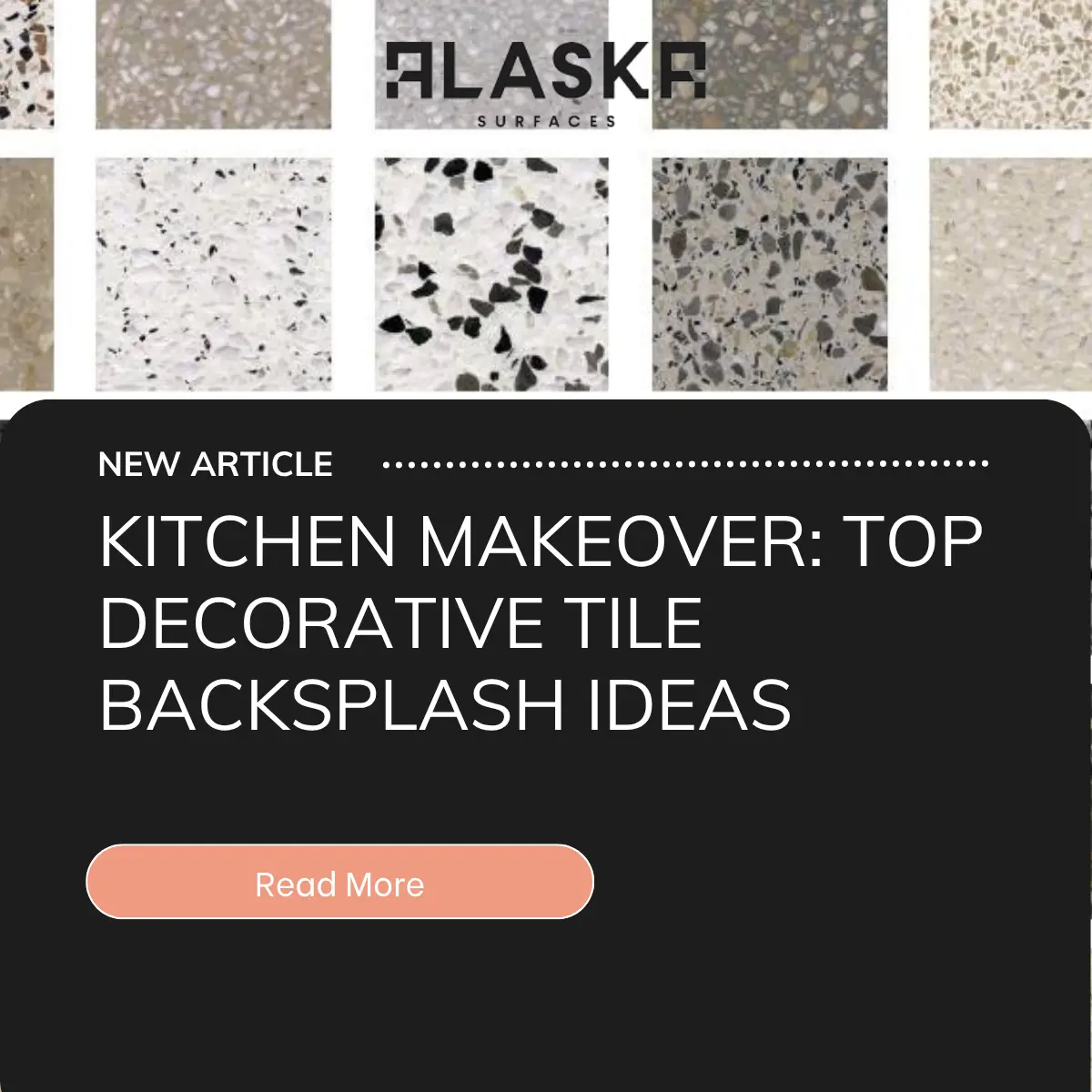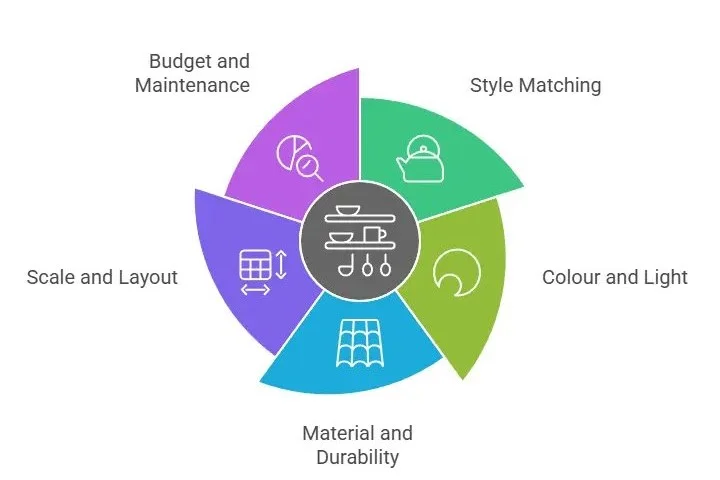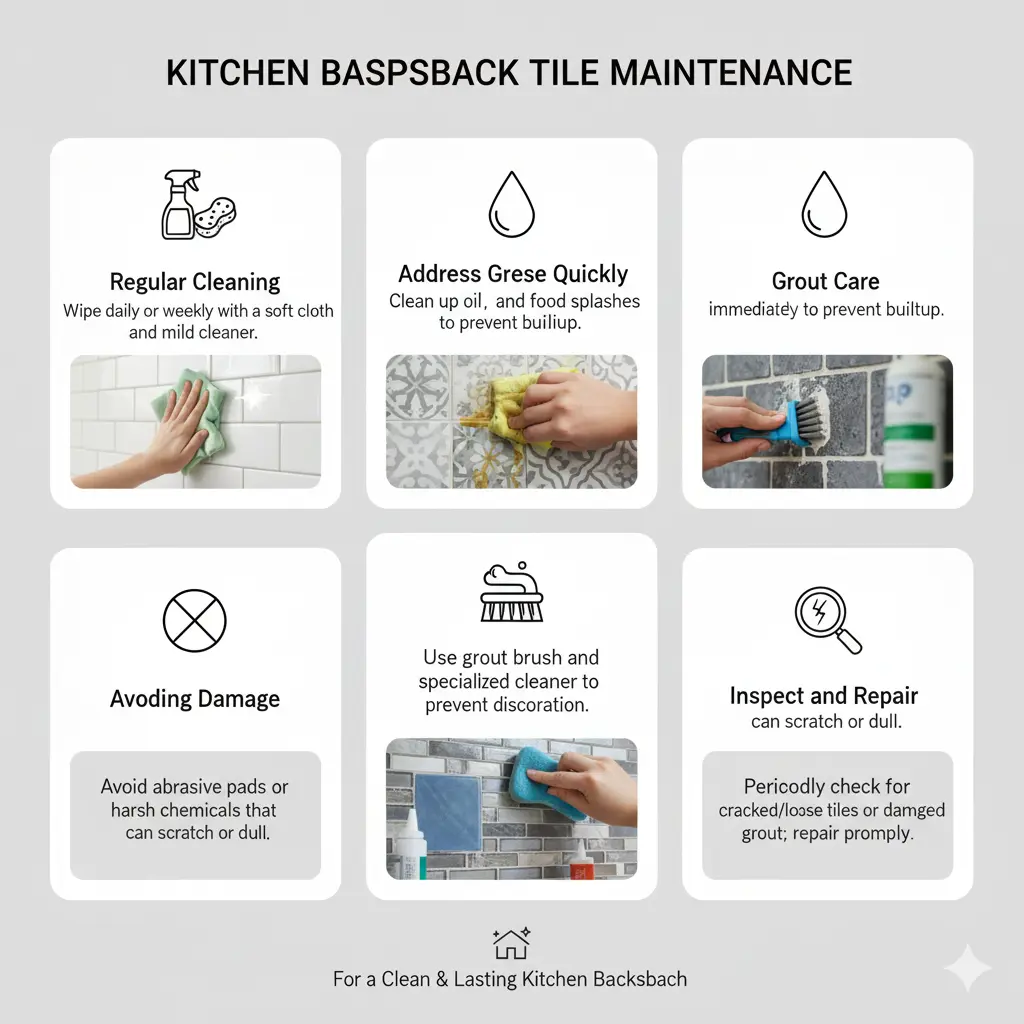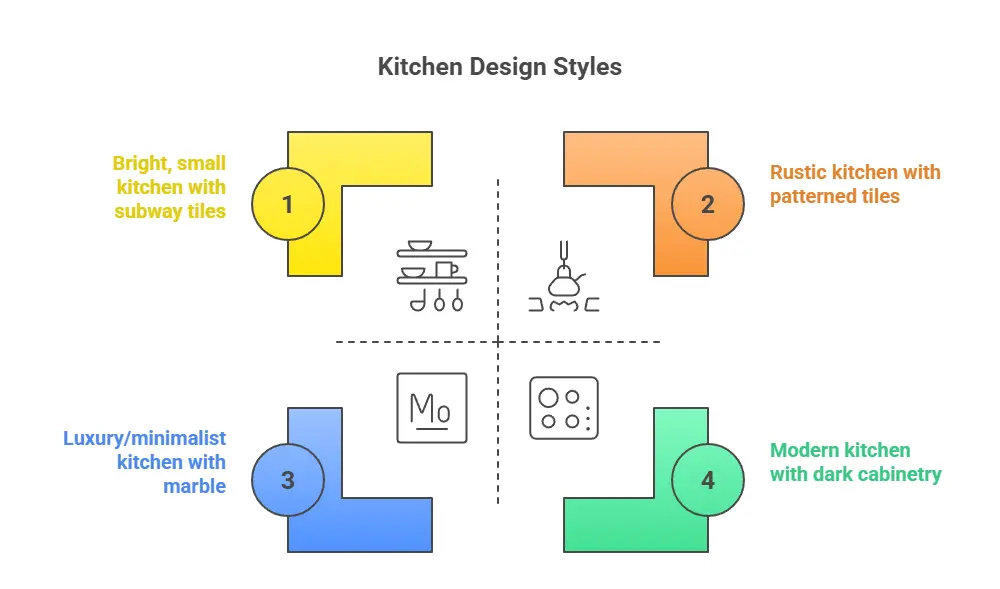3 October, 2025

A kitchen isn’t just a place to cook it’s the heart of the house. It’s where warm meals are prepared, conversations flow, and family and friends gather to create lasting memories. Every aspect of a kitchen its layout, cabinetry, lighting, finishes contributes to the atmosphere. Among these, one often under-appreciated but high-impact feature is the Kitchen backsplash. It protects, beautifies, and can tie together all of the design elements. In this post, we’ll explore how to choose the right backsplash tile , inspiring design directions, materials, installation tips, maintenance, and budget considerations a full guide to making your kitchen both functional and beautiful.
Introduction to Kitchen Design
When designing a kitchen, we often focus first on the large, expensive elements: countertops, cabinetry, floors, layout of the sink and stove, and lighting. But finishes like the Kitchen backsplash tile often punch above their weight in the visual impact they deliver. A well designed kitchen needs careful consideration of multiple interlocking elements:
-
Functionality: Where the sink is, where splashes and heat are likely, how easy it is to clean.
-
Style / Aesthetic coherence: The relationships among cabinets, countertops, hardware, appliances, wall and floor colors.
-
Light and space: How much natural light and artificial light you have, whether surfaces reflect or absorb light.
-
Durability: Kitchens are high use areas, exposed to moisture, stains, heat, and grease. Choosing durable materials that can cope is essential.
The backsplash tile goes between your countertops and cabinets or sometimes extends all the way up to ceiling or across full wall height. It protects walls from stains, moisture, heat from stovetops, and provides a surface easier to wipe with a soft sponge than plaster or painted drywall. It also gives you a canvas to add colour, texture, pattern and personality.
Choosing the Right Kitchen Backsplash

Matching the style of other elements
-
Countertops: If your countertops are very busy (marble with veining, or patterned stone), you might want a backsplash tile that shows clean lines so the room doesn’t feel overwhelming. If the countertops are plain, the backsplash can be the bold statement.
-
Upper cabinets: Their finish (matte, glossy), colour (light, dark, neutral), and style (modern, rustic, shaker, flat panel) will influence what kind of tile goes well.
-
Appliances & hardware: Chrome, brushed metal, gold/brass, black matte all these reflect in details such as trims, grout, or tile accents.
Colour, tone, light
-
Natural light vs. artificial lighting will change how tiles look. Glossy tile reflects light, helping brighten a dim space; matte or textured stone tiles absorb more light.
-
Neutral vs. bold: neutrals are safe and timeless; classic colors or patterns make a splash but need more care.
Material and durability
-
Glass Tile: Sleek, reflective, and easy to clean.
-
Natural Stone: Timeless, elegant, and rich in texture.
-
Mosaic: Great for patterns, colors, and artistic touches.
-
Ceramic & Porcelain: Durable, affordable, and versatile.
-
Grout type matters: lighter grout shows stains; darker grout or coloured grout may hide splashes but has to be cleaned to avoid mould etc.
Scale, layout, pattern
-
Size of the tile: small mosaic tiles give texture and pattern, but more grout to maintain. Large format tiles have fewer joints, easier cleaning, but require more precise installation.
-
Pattern / orientation: subway, herringbone, vertical vs horizontal laying, diagonal, chevron, etc. These change visual perception of space (height, width) and style (modern vs traditional).
Budget and maintenance
-
Material cost + installation cost + long term maintenance (cleaning, sealing, repairing).
-
Some high-end materials like stone or glass mosaics are more expensive and delicate; others like ceramic and porcelain are more affordable and easier to keep up.
Design Ideas and Inspiration
Here are some specific decorative backsplash tile design directions to consider, with examples and what makes them work:
-
Glossy zellige or handmade tiles: Zellige tiles add a unique artisanal craftsmanship feel with irregular surfaces and vibrant colors. They reflect light beautifully and add a touch of creativity.
-
Matching or colour-harmonising with cabinetry: If your cabinets are painted a deep colour (e.g. sage green, navy, charcoal), repeating that colour in the backsplash tile ties things together. Using the same or similar hue in the tile helps the kitchen feel cohesive. Sometimes the same tile with a different texture or finish.
-
Neutral square tiles for bright, airy kitchens: Neutral tones create cleanliness and reflect light, making the room feel larger.
-
Marble with veining and stone countersplashes: Natural stone like marble or carrara provides elegance and luxury. Pairing marble countertops with a marble backsplash delivers seamless style.
-
Mixed materials and textures: Combine different materials such as glass tile, metal, and stone to add contrast and visual interest.
-
Bold, deep tones: Dark tile colours (deep green, navy, charcoal, black) are being used, often paired with warm lighting and lighter countertops or lighter cabinets. These bring a modern, dramatic flair.
-
Full-height or full-wall backsplashes: Instead of stopping at the bottom of upper cabinets, extending tile all the way up to the ceiling especially behind range hoods or on accent walls makes for a dramatic, continuous look. Also protects more wall from kitchen hazards.
-
Subway tiles and their variants: Classic rectangular tiles laid in offset brick patterns or vertical stacks create timeless patterns and cleanliness.
-
Patterned tiles / mosaic / artistic inlays: Use artistic mosaics or pebble-like textures for visual interest. They can bring vintage charm and add character.
-
Fluted / reeded tiles: These textured shapes add depth and creativity, perfect for a contemporary or modern look.
-
Warm, natural tones over cool greys: Moving away from stark whites, warmer tones like beige and cream create inviting surroundings that many homeowners love.
-
Accent zones: Add bold patterned tiles only in focal areas like behind the stove. This keeps costs down while still showcasing art and creativity.
-
Alternative shapes and unexpected design: Hexagons, elongated rectangles, chevrons, diamond shapes, even custom-cut tiles that break from straight lines. This allows personality to show.
Glass Tile Options
this tiles have unique properties that make them especially attractive for backsplashes:
-
Light reflection: Glass captures and reflects light, which can brighten up darker kitchens or add sparkle.
-
Colour richness: The finish and translucency of glass allow for vibrant hues, depth, metallic effects or even opalescent looks.
-
Low maintenance (if done well): Glass surface is less porous than many stones, easier to clean splashes; but grout and glue matter.
Some Glass tile ideas:
-
Use the behind sink area for visual interest.
-
These tiles with paint or film behind them give solid colour with glossy glass front.
-
Combine glass with stone or metal for texture contrast.
-
Use glass in lighter tones if the kitchen lacks natural light; darker or coloured glass if paired with plenty of ambient and task lighting.
Installation Tips
A great tile choice can still look sloppy if installed poorly. Here are pointers:
-
Layout planning: Dry-fit your tiles to check patterns and grout alignment with countertops and upper cabinets.
-
Grout selection: Choose grout colour to either highlight patterns or create seamless cleanliness.
-
Adhesives and preparation: Use strong mortar or thinset for heavy stone. Correct layout prevents cracks or uneven finishes.
-
Sealing: Seal porous materials like real stone and grout to resist stains and moisture.
-
Professional vs DIY: Some homeowners install backsplashes themselves, but hiring pros ensures perfect craftsmanship.
Kitchen Backsplash Tile Maintenance

Once your backsplash is in, keeping it looking great takes a little work and the right habits.
-
Regular cleaning: Use mild, non-abrasive cleaners. A soft cloth or sponge is usually enough. Avoid harsh wire brushes or very abrasive powders on delicate/glazed surfaces.
-
Address grease quickly: Grease buildup behind stoves can be tough; frequent wipe downs help.
-
Grout care: Grout can harbour stains or mildew. Periodic cleaning with gentle grout cleaner (or a vinegar-baking soda solution for ceramic/porcelain). Resealing periodically if needed.
-
Avoiding damage: Don’t use metal utensils or appliances directly against delicate tiles; splatters of strong acid or alkaline soaps should be wiped.
-
Inspect and repair: Over time, small cracks in grout can allow water behind tiles; fix them to avoid larger damage.
Materials and Textures
Here’s a comparison of common tile materials and textures to help you choose what aligns with your priorities:
| Material | Advantages | Considerations | Best Use Cases |
|---|---|---|---|
| Ceramic | Affordable, versatile, many patterns. | May chip, needs regular cleaning. | Traditional or modern backsplashes. |
| Porcelain | Durable, luxury feel, available in large shapes. | Heavier, requires precise installation. | Sleek modern designs. |
| Glass | Reflective, colourful, low maintenance. | Fragile, careful cutting needed. | Contemporary kitchens needing classic colors. |
| Natural Stone (marble, travertine, slate, etc.) | Timeless, elegant textures. | Porous, must be sealed, can stain. | High-end projects with luxury finishes. |
| Metal / Metallic Tiles | Adds shine, modern edge. | Can scratch or show stains. | Accents behind appliances or stove. |
| Textured Tiles (fluted, ridged, relief, 3D) | Adds depth and interest. | More expensive; need careful installation. | Accent back panels; around stoves. |
Budget and Cost
Budget planning is crucial. Here’s how to think about it:
-
Material cost: Tile price per sq. foot, plus extra for specialty tiles, decorative or mosaic pieces.
-
Installation: Labour can be significant especially if tiles are small mosaics or require cutting, patterning, or use of stone. Also more labour if the wall needs pre-prep (flattening, waterproofing).
-
Sealing / maintenance cost: Stone sealing, periodic grout sealing or cleaning, maybe even replacing a few tiles after damage.
-
Waste / overage: Always buy more than you need, 10-15% extra to account for cuts, mistakes, cracks ones. For patterned tile or stone, more overage may be needed.
-
Cost vs. return: A stylish backsplash tile can boost perceived value of the kitchen, which can help when selling a home. On the other hand, very niche or overly bold designs may appeal less to some buyers.
A rough budget breakdown:
-
Low budget: Basic ceramic or porcelain subway tiles; simple layout, minimal cutting.
-
Mid-range: Mosaic accents, mixed materials (e.g. glass + stone), some colour or pattern, moderate installation complexity.
-
High end / Luxury: real stone with pronounced veining, full height/countersplash, custom, special finishes, high labour costs.
Putting It All Together: Example Scenarios

To help you visualize how these ideas combine in real kitchens, here are a few scenario ideas:
Bright, small kitchen with lots of natural light
-
Use light neutral subway or square tiles with gloss finish to bounce light.
-
Keep pattern simple; grout colour close to tile colour to keep visual flow.
-
Use accent tile just behind the stove in a subtle pattern or different texture for interest.
Modern kitchen with dark cabinetry
-
Use darker or bold colour tiles (e.g. deep green, navy, charcoal) for backsplash; pair with lighter countertops.
-
Consider matte finish or even texture (to reduce glare).
-
Use under-cabinet lighting to highlight tile surface and workspaces.
Rustic or country style kitchen
-
Handmade tiles (terracotta, zellige style), perhaps with warm, earthy tones.
-
Patterned decorative tiles (e.g. encaustic or ceramic with folk/traditional motifs).
-
real stone or wood trim, exposed beams etc., to match.
Luxury/minimalist kitchen
-
Marble countersplash or stone slab with full height to ceiling behind hood.
-
Very fine, narrow grout lines; minimal visual breaks.
-
Texture via material rather than pattern elegant veining, refined edges.
Conclusion
A decorative tile backsplash is more than just decoration it’s one of the key finishing touches that pulls together the functional, aesthetic, and emotional sides of a kitchen. The right choice of tile, colour, texture, pattern, and layout can elevate a simple kitchen into a warm, inviting, beautiful space that reflects your style. Pay attention to light, maintenance, coherence with other design elements, and your budget and don’t be afraid to make a statement, whether subtle or bold.
FAQs
1. What to put on top of a tile backsplash?
Add trim, crown molding, or extend tiles to the ceiling for a finished look.
2. What is the trend in backsplash tile in 2025?
Bold patterns, textured tiles, recycled glass, and large-format slabs.
3. What is the current trend for kitchen backsplashes?
Herringbone, Moroccan patterns, metallic accents, and neutral tones.
4. How to decorate over kitchen tiles?
Use peel-and-stick panels, artwork, or floating shelves.
5. How can I decorate my kitchen tiles without removing them?
Apply decals, paint, or peel-and-stick covers for an easy update.
6. What is a cheap alternative to backsplash?
Peel-and-stick tiles, beadboard, or waterproof wallpaper.